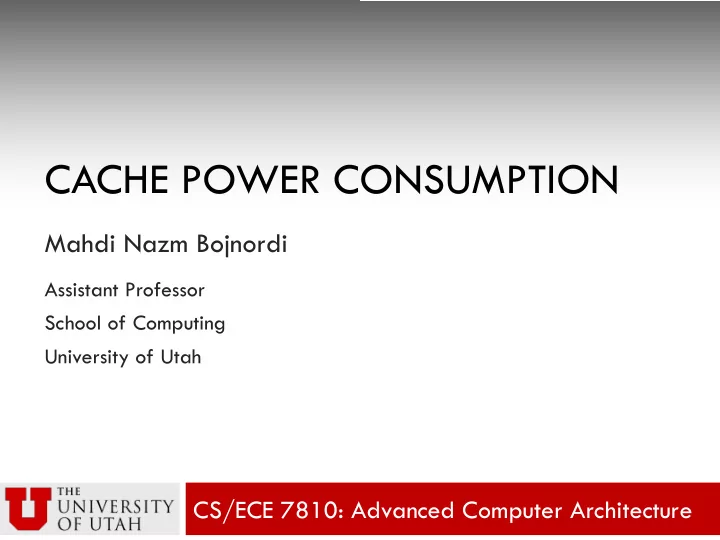

CACHE POWER CONSUMPTION Mahdi Nazm Bojnordi Assistant Professor School of Computing University of Utah CS/ECE 7810: Advanced Computer Architecture
Overview ¨ Upcoming deadline ¤ Feb. 3 rd : project group formation ¨ This lecture ¤ Cache power consumption ¤ Cache banking ¤ Way prediction ¤ Resizable caches ¤ Gated Vdd/ cache decay, drowsy caches
Main Consumers of CPU Resources? ¨ A significant portion of the processor die is occupied by on-chip caches Example: FX Processors ¨ Main problems in caches ¤ Power consumption n Power on many transistors ¤ Reliability n Increased defect rate and errors [source: AMD]
Recall: CPU Power Consumption ¨ Major power consumption issues Peak Power/Power Density Average Power q Heat q Battery life o Packaging, cooling, o Bulkier battery component spacing q Utility costs q Switching noise o Probability, cannot run o Decoupling capacitors your business! Caches generate little heat Caches consume high (low activity factor) average power (~1/3)
Cache Power Management ¨ Circuit techniques ¤ Transistor sizing, multi-Vt, low-swing bit-lines, etc. ¨ Microarchitecture techniques ¤ Static techniques n banking, phased tag/data access, way prediction ¤ Dynamic techniques n gated-Vdd, cache decay, drowsy caches ¨ Compiler techniques ¤ Data partitioning to enable sleep mode
Recall: Cache Lookup tag index byte ¨ Byte offset: to select v the requested byte 0 1 ¨ Tag: to maintain the 2 address ¨ Valid flag (v): … whether content is 1021 meaningful 1022 1023 ¨ Data and tag are = always accessed data hit
Cache Architecture ¨ Physical cache structure [CACTI 1.0]
Cache Banking ¨ Divide cache into multiple identical arrays ¤ Static power: unused arrays may be turned off ¤ Dynamic power: only the target arrays is accessed [Source: CACTI]
Basic Set Associative Cache tag set offset tag0 data0 tag1 data1 tag2 data2 tag3 data3 =? Mux 4:1 To CPU Power per access: 4T + 4D
Phased N-way Cache tag set offset tag0 data0 tag1 data1 tag2 data2 tag3 data3 =? Mux 4:1 To CPU Power per access: 4T + 1D But access time increases
Way-prediction N-way Cache tag set offset Way-prediction tag0 data0 tag1 data1 tag2 data2 tag3 data3 =? Mux 4:1 To CPU To CPU Correct prediction: 1T + 1D Predict instead of sequential tag access [Powell02]
Way Prediction Summary ¨ To improve hit time, predict the way to pre-set Mux ¤ Mis-prediction gives longer hit time ¤ Prediction accuracy n > 90% for two-way n > 80% for four-way n I-cache has better accuracy than D-cache ¤ First used on MIPS R10000 in mid-90s ¤ Used on ARM Cortex-A8 ¨ Extend to predict block as well ¤ “Way selection” ¤ Increases mis-prediction penalty
Cache Size ¨ Energy dissipation of on-chip cache and off-chip memory Cache Memory Total 5 core 4.5 4 RELATIVE ENERGY 3.5 3 Cache 2.5 2 1.5 1 Memory 0.5 0 CACHE SIZE Can we dynamically resize cache? Ways, sets, or blocks? [Zhang04]
Resizable Caches ¨ Resizable caches turn off portions of the cache that are not heavily used by the running program [Albonesi99]
Leakage Power ¨ dominant source for power consumption as technology scales down ! "#$%$&# = (×* +#$%$&# 100% Leakage Power/Total Power 80% 60% 40% 20% 0% 1999 2001 2003 2005 2007 2009 Year [source of data: ITRS]
Dynamic Techniques for Leakage ¨ Three example microarchitectural approaches ¤ Gated-Vdd n Gate the supply-to-ground path ¤ Cache decay n Same gating mechanism but different control policy ¤ Drowsy caches n Reduce the Vdd in order to retain cell state
Recommend
More recommend